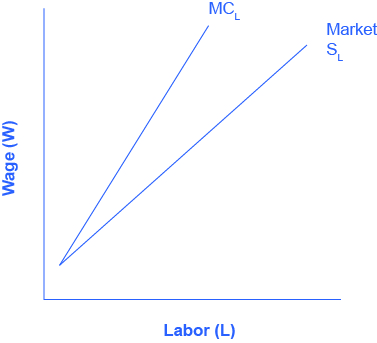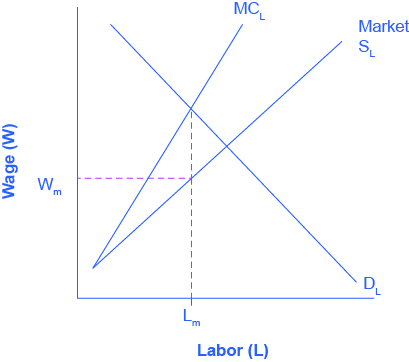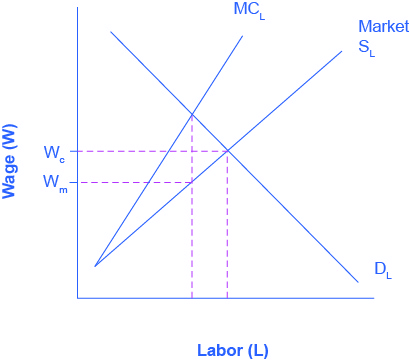How Can Competition in a Scarce Labor Market Affect Wages
Labor Markets and Income
Wages and Employment in an Imperfectly Competitive Labor Market
Learning Objectives
By the end of this department, y'all volition be able to:
- Define monopsony ability
- Explain how imperfectly competitive labor markets determine wages and employment, where employers accept market power
In the capacity on market structure, we observed that while economists use the theory of perfect competition as an ideal example of market place structure, there are very few examples of perfectly competitive industries in the real globe. What about labor markets? How many labor markets are perfectly competitive? There are probably more examples of perfectly competitive labor markets than perfectly competitive production markets, but that doesn't mean that all labor markets are competitive.
When a chore applicant is bargaining with an employer for a position, the applicant is often at a disadvantage—needing the job more than than the employer needs that particular applicant. John Bates Clark (1847–1938), oft named as the first great American economist, wrote in 1907: "In the making of the wages contract the individual laborer is ever at a disadvantage. He has something which he is obliged to sell and which his employer is not obliged to take, since he [that is, the employer] can reject unmarried men with impunity."
To requite workers more than power, the U.S. government has passed, in response to years of labor protests, a number of laws to create a more equal residue of power between workers and employers. These laws include some of the following:
- Setting minimum hourly wages
- Setting maximum hours of work (at least before employers pay overtime rates)
- Prohibiting child labor
- Regulating health and safety conditions in the workplace
- Preventing discrimination on the basis of race, ethnicity, gender, sexual orientation, and age
- Requiring employers to provide family exit
- Requiring employers to give advance detect of layoffs
- Roofing workers with unemployment insurance
- Setting a limit on the number of immigrant workers from other countries
(Figure) lists some prominent U.South. workplace protection laws. Many of the laws listed in the table were simply the offset of labor market regulations in these areas and have been followed, over time, past other related laws, regulations, and court rulings.
| Police | Protection |
|---|---|
| National Labor- Management Relations Act of 1935 (the "Wagner Act") | Establishes procedures for establishing a union that firms are obligated to follow; sets up the National Labor Relations Board for deciding disputes |
| Social Security Actof 1935 | Nether Title 3, establishes a state-run system of unemployment insurance, in which workers pay into a state fund when they are employed and received benefits for a time when they are unemployed |
| Fair Labor Standards Act of 1938 | Establishes the minimum wage, limits on child labor, and rules requiring payment of overtime pay for those in jobs that are paid by the 60 minutes and exceed forty hours per calendar week |
| Taft-Hartley Act of 1947 | Allows states to make up one's mind whether all workers at a firm can be required to bring together a spousal relationship as a condition of employment; in the case of a disruptive union strike, permits the president to declare a "cooling-off period" during which workers have to render to piece of work |
| Civil Rights Human action of 1964 | Title 7 of the Act prohibits bigotry in employment on the ground of race, gender, national origin, faith, or sexual orientation |
| Occupational Health and Prophylactic Act of 1970 | Creates the Occupational Safe and Health Administration (OSHA), which protects workers from physical damage in the workplace |
| Employee Retirement and Income Security Act of 1974 | Regulates employee alimony rules and benefits |
| Pregnancy Discrimination Human action of 1978 | Prohibits discrimination against women in the workplace who are planning to get meaning or who are returning to work after pregnancy |
| Immigration Reform and Control Act of 1986 | Prohibits hiring of illegal immigrants; requires employers to ask for proof of citizenship; protects rights of legal immigrants |
| Worker Aligning and Retraining Notification Human activity of 1988 | Requires employers with more than 100 employees to provide written notice 60 days earlier plant closings or large layoffs |
| Americans with Disabilities Human action of 1990 | Prohibits discrimination against those with disabilities and requires reasonable accommodations for them on the job |
| Family and Medical Go out Act of 1993 | Allows employees to take up to 12 weeks of unpaid go out per year for family reasons, including nascency or family disease |
| Pension Protection Act of 2006 | Penalizes firms for underfunding their pension plans and gives employees more than data about their alimony accounts |
| Lilly Ledbetter Fair Pay Human action of 2009 | Restores protection for pay discrimination claims on the footing of sex, race, national origin, age, organized religion, or inability |
At that place are ii sources of imperfect competition in labor markets. These are demand side sources, that is, labor market power by employers, and supply side sources: labor market power by employees. In this section nosotros will talk over the sometime. In the next section we will discuss the latter.
A competitive labor marketplace is i where there are many potential employers for a given type of worker, say a secretary or an accountant. Suppose there is merely ane employer in a labor market. Because that employer has no straight contest in hiring, if they offer lower wages than would be in a competitive market, employees volition have few options. If they want a task, they must take the offered wage rate. Since the employer is exploiting its market power, we telephone call the firm a monopsony. The classical example of monopsony is the sole coal visitor in a West Virginia boondocks. If coal miners want to piece of work, they must take what the coal company is paying. This is not the only example of monopsony. Think well-nigh surgical nurses in a boondocks with only one hospital. Employers that take at least some market power over potential employees is not that unusual. After all, nearly firms have many employees while in that location is just one employer. Thus, fifty-fifty if at that place is some competition for workers, information technology may not feel that way to potential employees unless they practice their research and notice the opposite.
How does market power past an employer affect labor market place outcomes? Intuitively, i might think that wages will be lower than in a competitive labor marketplace. Allow's evidence information technology. We will tell the story for a monopsonist, but the results will exist qualitatively like, although less farthermost for any firm with labor market ability.
Call up back to monopoly. The good news is that because the monopolist is the sole supplier in the market, information technology can charge any price it wishes. The bad news is that if it wants to sell a greater quantity of output, it must lower the price it charges. Monopsony is analogous. Because the monopsonist is the sole employer in a labor marketplace, it can offering any wage that it wishes. Yet, considering they face the market supply bend for labor, if they want to hire more workers, they must heighten the wage they pay. This creates a quandary, which we tin can understand by introducing a new concept: the marginal cost of labor. The marginal cost of labor is the cost to the business firm of hiring one more worker. However, here is the thing: we assume that the business firm is determining how many workers to hire in total. They are not hiring sequentially. Let'south wait how this plays out with the instance in (Figure).
| Supply of Labor | 1 | 2 | three | 4 | 5 |
| Wage Rate | $1 per hour | $2 per hour | $3 per hr | $4 per 60 minutes | $five per hour |
| Total Cost of Labor | $ane | $4 | $9 | $16 | $25 |
| Marginal Toll of Labor | $1 | $iii | $5 | $7 | $9 |
There are a couple of things to notice from the table. First, the marginal cost increases faster than the wage rate. In fact, for any number of workers more than ane, the marginal cost of labor is greater than the wage. This is because to hire one more worker requires paying a higher wage rate, not merely for the new worker but for all the previous hires also. Nosotros can see this graphically in Figure fourteen.7.
The Marginal Cost of Labor
Since monopsonies are the sole demander for labor, they confront the marketplace supply curve for labor. In order to increment employment they must raise the wage they pay non just for new workers, but for all the existing workers they could have hired at the previous lower wage. Equally a result, the marginal cost of boosted hiring labor is greater than the wage, and thus for any level of employment (above the kickoff worker), MCL is above the Marketplace Supply of Labor.

Labor Marketplace Outcomes Under Monopsony
A monopsony will hire workers up to the point Lm where its demand for labor equals the marginal cost of additional labor, paying the wage Wm given past the supply curve of labor necessary to obtain Lm workers.

If the business firm wants to maximize profits, information technology volition hire labor upward to the point Lm where DL = VMP (or MRP) = MC50., every bit (Figure) shows. And then, the supply curve for labor shows the wage the firm will have to pay to attract Lm workers. Graphically, we can draw a vertical line up from Lm to the Supply Curve for label and then read the wage Wm off the vertical axis to the left.
How does this outcome compare to what would occur in a perfectly competitive market? A competitive market would operate where DFifty = SL, hiring Lc workers and paying Wc wage. In other words, nether monopsony employers hire fewer workers and pay a lower wage. While pure monopsony may be rare, many employers have some degree of market ability in labor markets. The outcomes for those employers volition exist qualitatively like though non equally extreme as monopsony.
Comparison of labor market outcomes: Monopsony vs. Perfect Competition
A monopsony hires fewer workers Lm than would exist hired in a competitive labor market Lc. In exploiting its market power, the monopsony can also pay a lower wage Wm than workers would earn in a competitive labor market place Wc.

Key Concepts and Summary
A monopsony is the sole employer in a labor market. The monopsony can pay any wage it chooses, bailiwick to the market supply of labor. This means that if the monopsony offers too low a wage, they may not discover enough workers willing to piece of work for them. Since to obtain more than workers, they must offer a college wage, the marginal cost of boosted labor is greater than the wage. To maximize profits, a monopsonist will hire workers up to the signal where the marginal price of labor equals their labor demand. This results in a lower level of employment than a competitive labor market would provide, but as well a lower equilibrium wage.
Disquisitional Thinking Questions
What is the marginal cost of labor for a house that operates in a competitive labor marketplace? How does this compare with the MCL for a monopsony?
Given the reject in union membership over the past l years, what does the theory of bilateral monopoly suggest will have happened to the equilibrium level of wages over time? Why?
References
Clune, Michael South. "The Fiscal Impacts of Immigrants: A California Example Written report." In The Immigration Debate: Studies on the Economic, Demographic, and Fiscal Effects of Immigration, edited by James P. Smith and Barry Edmonston. Washington, DC: National University Press, 1998, 120–182. http://www.nap.edu/openbook.php?record_id=5985&page=120.
Smith, James P. "Immigration Reform." Rand Corporation: Rand Review. http://world wide web.rand.org/pubs/periodicals/rand-review/issues/2012/autumn/leadership/immigration-reform.html.
U.S. Department of Homeland Security: Role of Immigration Statistics. "2011 Yearbook of Clearing Statistics." September 2012. http://world wide web.dhs.gov/sites/default/files/publications/clearing-statistics/yearbook/2011/ois_yb_2011.pdf.
Glossary
- monopsony
- a labor market where there is only ane employer
gonzalezsherting1989.blogspot.com
Source: https://opentextbc.ca/principlesofeconomics2eopenstax/chapter/wages-and-employment-in-an-imperfectly-competitive-labor-market/
0 Response to "How Can Competition in a Scarce Labor Market Affect Wages"
Post a Comment